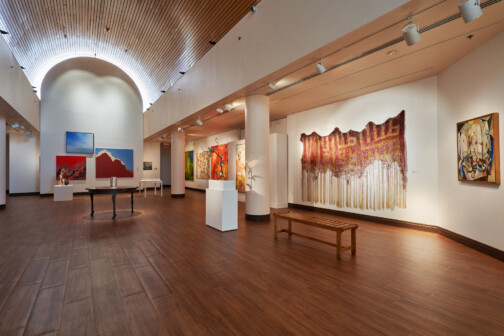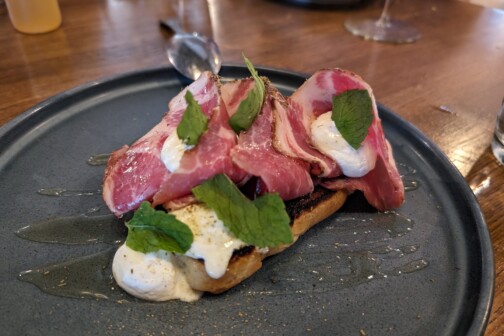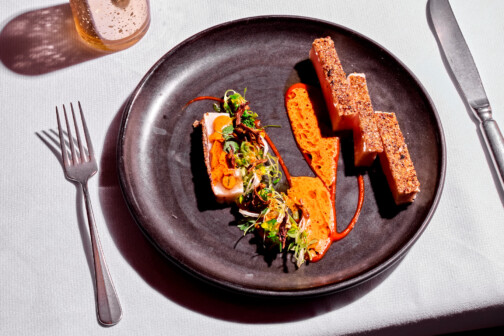If You Look Hard Enough, You Can See Our Future consists of 62 works by South African artists and spans two upstairs rooms at the African American Museum at Fair Park. The exhibition pulls from the corporate collection of the South African restaurant chain Nando’s and originated in 2019 when Dick Enthoven, the late billionaire owner of the company, approached Dallas-based curator Laurie Ann Farrell to organize the show.
Enthoven initiated Nando’s art collection with the help of the arts consultancy Spier Arts Trust in 2001, which remains involved and assisted with the exhibition at the African American Museum. (Enthoven also owned the Spier Wine Farm, with which the Spier Arts Trust is associated.) Farrell first curated a 2004 exhibition at The Museum for African Art in New York and the Cathedral of St. John the Divine to mark the 10th anniversary of South African democracy, using newly commissioned artworks separate from the Nando’s collection.
Today, the chain is believed to have the largest collection of contemporary South African art in the world, which includes more than 25,000 works. Nando’s—a fast-casual purveyor of peri-peri chicken—displays this vast collection in over a thousand locations in 21 countries worldwide. In a sign of its marketing power, the company even sponsors the fictional AFC Richmond soccer team in the Apple TV+ show Ted Lasso.
In effect, the restaurant chain uses South African art to create its visual brand identity, positioning itself as deeply South African not only in food but in image. In an interview, Farrell said the exhibition at the African American Museum was initially timed with the opening of Nando’s first Texas restaurants this summer. While Nando’s already has locations on the East Coast and in Illinois, the Houston and Addison outposts mark the chain’s first expansion into the Texas market. In many ways, it feels like the exhibition is more about Nando’s than the art itself. (After publication, the company says the show was planned separate from the restaurant openings.)
The show is comprised primarily of two-dimensional work made between 1948 and 2020, divided into two crowded and colorful galleries organized around themes of portraiture, place, and abstraction. According to a press release, the goal of the exhibition is to convey “the unity of Southern African art” through the “[collection’s] distinct aesthetics, while also engaging with universal themes of humanity, love, loss and hope for a better future.”
Yet, the decision to present a unified image of South African art rooted in an appeal to our common humanity feels misplaced. Owing to a history of colonialism, political turmoil, and apartheid, South Africa isn’t a unified place; if art reflects society, then it follows that South African art engages with these complicated realities. Many South African artists do consider these realities—including many whose work is shown in this exhibition—but the decision to present so many pieces in so little space obscures this fact. The exhibition concept preceded the venue, and it is possible that the show was curated with a larger gallery in mind. And yet, in its current form, it is far too easy to experience the exhibition at face value: as colorful, energetic, and unified.

While Farrell had complete creative control in building the show, she was limited to works within the Nando’s collection. Because Nando’s collects with an eye toward decorating its restaurants, it follows that the company would invest in artwork that is palatable to the restaurant experience, or colorful, two-dimensional, and not too political.
Artwork that frankly depicts inequality can’t be good for selling chicken. As a viewer, however, it would have been much more interesting to experience a show that embraced the complicated realities of South Africa today.
Individual works in the show do embrace these complicated realities, and three in particular stand out due to their specificity, direct engagement with history, and skilled use of materials.
The first is Zanele Muholi’s 2016 photograph Fisani, Parktown, which has its own wall just outside the first gallery. Mounted directly on the wall, the piece is a larger than life, black-and-white photograph of the artist in three-quarters view, glancing at something outside the frame. Like the rest of the photos in the artist’s Somnyama Ngonyama series (isiZulu for “Hail the Dark Lioness”), Fisani, Parktown, uses the self-portrait format to probe ideas of race and identity.
Here, Muholi wears oversized safety pins in their hair and around their neck, their dark skin nearly blending into the background while the safety pins and whites of their eyes catch all the light. It is this interplay of light and dark, of high and low contrast, that gives the photo a presence that both belies the fact that it’s wallpaper and holds the viewer.
With its interest in identity and the individual’s role in history, Tamlin Blake’s 2019 piece Tied by Time builds on the tone set by Fisani, Parktown. (Though in an instance of strangeness, Blake is chief curator at Spier Arts Trust, the arts consultancy that aided with the exhibition.) Across six floor-to-ceiling panels, the newspaper tapestry tells the story of the Four Industrial Revolutions through the lens of Blake’s family, speaking to the anonymizing effects of mechanized labor.
Visual motifs—light fixtures, curlicue tiling, female figures—recur throughout the panels, suggesting a progression across time and space. In one panel, a series of sewing machines stitch the soft parts of baby dolls, their disembodied heads looming while the anonymous factory laborers of the Second Industrial Revolution remain conspicuously absent. In a colorless panel, the ghostly outline of Blake’s younger daughter hints at the developing possibilities of the Fourth Industrial Revolution: uploaded consciousness, AI, gene editing, and a general collapsing of the physical, biological, and digital.
Blake has chosen an incredibly labor-intensive method to chronicle the technological advancements of the past two centuries. Before weaving, she dyes, cuts, and spins the newspaper. Because the recent past is encoded in the woven fibers of the newspaper, the piece becomes a document of the present as well as the past.
In the second room, Igshaan Adams’ 2017 Shahada II (Part I) posits weaving as a multilayered practice that creates physical objects, builds community, and ties the weaver to the past. Named for an Islamic oath, the piece hangs more than eight feet wide on the wall and looks like a tapestry fragment uncovered in an archeological dig. It is made of cotton thread and maroon and ochre seed beads, and simultaneously reads as a rug, shawl, and patterned floor.
In a practice that moves beyond his individual identity, Adams’ pieces are made by teams of weavers; Shahada II (Part I) holds the ghosts of a community of people. Like Blake’s work, history is embedded in the piece.
While Fisani, Parktown, Tied by Time, and Shahada II (Part I) share a certain synergy and depth, the show is too crowded to effectively function as a snapshot of South African art today. In an exhibition that focuses on aesthetics, the pieces that probe history and identity are drowned out by the sheer number of works.
Patronage is a significant source of support in the arts, and the Nando’s art collection has a track record of supporting emerging South African artists. But If You Look Hard Enough avoids digging into the real, complicated realities of South Africa today, and effectively presents a vision of a nation that is little more than colorful and diverse.
Maybe it is unrealistic to expect better from the art collection of a major multinational corporation, but it is disheartening to realize that the aesthetically overwhelming and apolitical nature of the exhibition benefit Nando’s bottom line, a bottom line that will make rich stockholders richer in a country with the worst economic inequality in the world.
If the timing of the show had been different—perhaps if it had opened a year ago, or a year from now—these concerns wouldn’t be top of mind. But instead, the show coincides with the restaurant’s Addison debut. The company is using South African art to push its own agenda. And that agenda is selling chicken.
If You Look Hard Enough, You Can See Our Future is on view at the African American Museum through August 13.
CORRECTION: There are 62 pieces in the exhibit, not close to 90, and they were pulled from Nando’s corporate collection, not private collection as originally stated. Farrell also curated a first exhibit at The Museum for African Art in New York and the Cathedral of St. John the Divine, not the Museum of African American Art.






